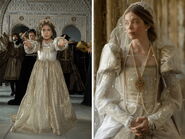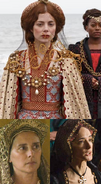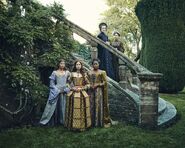Catherine of Aragon is the protagonist of The Constant Princess, is one of the main characters of The Other Boleyn Girl and is one of many main characters in The Spanish Princess[1]. She is the last daughter of King Ferdinand II of Aragon and Queen Isabella I of Castile, the former wife of Prince Arthur Tudor (though she claimed the marriage was not consummated and therefore had no legal standing) and the first wife of King Henry VIII, making her Queen of England. She was the mother of several children, though only one, Mary Tudor(later Queen Mary I), survived past infancy.
The Constant Princess (novel)[]
Catherine is the main protagonist in The Constant Princess. We first meet Catherine as a five-year-old girl with her parents who are being attacked by the Moors. The novel follows her through her childhood in Spain to England and her marriages to Henry and Arthur. The novel mostly focuses on her desperation to get pregnant and her fear that she is losing her husband to a nobody.
She is portrayed as a fiercely proud woman who knows that she was born to rule England and be a good, faithful wife to Prince Arthur and King Henry. She thinks a lot about her heritage and her mother's strong and stern personality that she draws strength upon in time of crisis.
Spain[]
The novel begins in 1491 Grenada as the Moors raid the military camp of Queen Isabella of Castile. The young Infanta Catalina watches with adoration as her warrior mother gathers her army and puts out the flames caused by the night raid. Upon her mother’s return, Catalina assures her mother that she was not afraid as she is a Spanish Princess and Princess of Wales. Catalina’s parentage and titles are incredibly important to her, even as a young child, as she prepares for her destiny as Queen of England. The morning after the raid, the Spanish generals suggest retreating due to lack of supplies but Isabella pushes the army onwards to vanquish the Moors from their last foothold in Spain. Isabella resolves their lack of shelter by commanding they build a stone fortification using the natural resources of the barren countryside. Her king, Ferdinand of Aragon acquiesces and begins work on stone structure beneath the cliff were the Moors have held the Red Fort for two centuries. Isabella and Ferdinand keep building in the unrelenting heat and against all odds until they found the siege town of Sante Fe.
A short while later, Catalina comes upon one of the great Spanish lords, Don Hernando Perez del Pulgar, and convinces him to confide in her. Hernando tells her he will break into the Alhambra to practice his Catholicism in the mosque and leave an Ava Maria. Catalina promises not to sleep until he returns but when he doesn’t return it dawns on Catalina that people can fail and be killed even if she believes they have God’s blessing. This puts the first doubts about God’s favour in her mind. Fortunately, Hernando and his friends survived and regale the court with their tale of desecrating the mosque. While taking her children to see the fortifications at Zubia, Queen Isabella is informed that the full Moors army is riding out of the Red Fort in retaliation for Hernando’s desecration. Queen Isabella, unable to flee the oncoming army, takes her children to hide on a roof to see what the army intends to do. A Moor named Yarfe comes to challenge Hernado by throwing the Ava Maria back in prevocational insult. Queen Isabella leads her children in prayer that her greatest champion Garallosco de la Vega will appear to defend them and gives her blessing when he arrives to challenge Yarfe. A short battle ensues whereby Vega kills Yarfe and Yarfe’s death signals the soldiers to pour out from the Red fort. Queen Isabella once again commands her daughters to pray despite their rising panic. Queen Isabella’s composure when faced with the moor’s army is well calculated; Yarfe’s death would be the last battle against the Spanish as the Moors lose all appetite for war and gift the Red Fort, containing the beautiful palace of the Alhambra, to Queen Isabella and King Ferdinand. With victory over the last of the expelled Moors, Queen Isabella and King Ferdinand begin to persecute and banish anyone that won’t convert to the Catholic faith from Spain. Catalina begins to see herself as a princess of the battlefield and firmly believes that she and her mother are favoured by God. Queen Isabella and King Ferdinand make the Alhambra their home and royal court which delights Catalina as she marvels in her surroundings. The luxury and beauty of the Alhambra make a lasting impression on Catalina and the last remaining years of her childhood are happy and tranquil compared to her early life of military campaign.
England[]
The novel resumes with fifteen-year-old Catalina’s arrival in England and her abrupt meeting with King Henry VII of England. As Catalina travels from the coast to London, she must camp overnight and as she is undressing for the night, King Henry barges into her tent despite the resistance of her Spanish servants trying to protect her modesty. King Henry angrily dismisses them as he forces his way into her bedchamber as Catalina just has time to veil her face with a mantilla. King Henry insists that since he’s paid for her then he will inspect her to his satisfaction and is utterly struck by Catalina’s beauty and feels a thud of lust when he imagines what he could do with her. The potency of her beauty and sex appeal (as well as Catherine's icy dignity) cow Henry as he commands her to meet her betrothed his son Arthur. Despite his feelings of arousal, Henry is still dismissive of her Spanish ways and determined that she will do as he commands while in England. Arthur Hovers nervously as he awaits his betrothed. Unlike his father, Arthur is approving of the public reaction to Catalina's progress through England and of her Spanish fashions (opinions that make him a "fool" in his father's eyes). Catalina is at last presented looking “ far more beautiful” and “a million times more haughty” than Prince Arthur had imagined. To his astonishment, she is impertinent and cool towards King Henry who is equally as curt and rude towards her as the three of them dine together. The meal is formal and uncomfortable with King Henry’s rudeness bringing out Catalina’s pride though Arthur sees through this to see the nervous young girl in a strange land she truly is and softens towards her. When Arthur privately apologizes for their dragging her from her tent, Catalina tells him that she is proud and fearless (though in truth she was frightened and used her determination to be Princess of Wales to calm her nerves). Over the course of the meal, King Henry admits Catalina is prettier than her portrait (finding her intriguing and still arousing) and Catalina tells them of her rough sea voyage to England. Arthur clumsily admits that his parents forced him to write his letters of courtship to Catalina which earns him a scolding from his father. King Henry requests Catalina to dance for them and finds himself increasingly irritated that such a sensual girl should be put in Arthur’s bed but is comforted by the thought of her impressive dowry and the wealth it would bring to England.
Three Sisters, Three Queens[]
the first section of the novel is told from Margaret Tudor's perspective and as such Catherine is viewed as a rival if the attention and affection of the English court. Margaret envies Catherine and is also deeply mistrustful of her motives and she partially blames Catherine for the deaths of her brother, mother and infant sister. She also criticises the growing bond between Catherine and Princess Mary.
The Other Boleyn Girl (novel)[]
Catherine was first introduced in the novel early on, and seen throughout the book through only the eyes of Mary Boleyn, who was initially her favourite and youngest lady-in-waiting.
In the beginning, Catherine and Henry were shown to be in a truly loving husband-wife relationship. However, as she aged and it became apparent that she could no longer conceive, he turned away from her to the Boleyn sisters - first Mary, then Anne. Anne, in particular, makes no secret of how she intended to be much, much more than Henry's mistress - she did not love or even desire him as a man, but was after Catherine's throne as Queen of England. Due to her own understanding of Henry, as well as his history of lovers and mistresses, Catherine initially believed that even the seductive, stylish, and ruthlessly ambitious Anne was just a passing phase of the King's, and therefore was not threatened by her in the least.
However, as it became evident that her marriage was really breaking down, Catherine demonstrated her strength, determination, and willingness to do anything to keep her husband. She even once stated to Mary that she did not prepare herself for defeat, for doing so would be to betray her own self, and persisted in her belief that Henry would eventually tire of Anne, as he did all his other previous lovers. Ultimately, she realized how Henry had well and truly tired of her as well, as well as how she was defeated - towards the end of the novel, she died disowned and only loved by her daughter, Mary, and a few loyal servants.
The Other Boleyn Girl (2003)[]
We first see Queen Catherine in 1524 as she takes up wearing a hair shirt in a desperate bid to become pregnant.
The Other Boleyn Girl (2008)[]

Katherine discovering she gave birth to a still born boy.
Catherine of Aragon first appearance in the movie is shortly after giving birth to a male still born child. Catherine is devastated by the loss of another the child and apologizes to her only living child Mary for not producing a male heir to make England safe for her.
The Spanish Princess (2019)[]
The show foretells storylines of many of the characters but they all lead up to Catherine. She is first seen leaving for England from Spain with her many handmaids. Each episode foretells a storyline in a matter of months of the many events.
Historical Figure[]
Catherine was born on the 16 December 1485, at the Archbishops Palace of Acala de Henares near Madrid. At the age three she was betrothed to Prince Arthur, the older brother of King Henry VIII . In 1501 she married Prince Arthur however their relationship was short lived as five months later he died. After seven years of being a widow Catalina married King Henry VIII on the 11th of June 1509. After twenty four years of marriage Catherine never managed to give Henry a son (they did have a daughter together called Mary I), so Henry was successful in divorcing her in favour of Anne Boleyn. She died on the 7th January 1536 at the age of fifty one of unexplained causes however, rumors spread that she had been poisoned or murdered by Anne and the King. Doctors performed an autopsy reported to see a black growth on her heart which they associated with poisoning however modern medical experts believe that it might have been cancer, a disease unknown in that time period.
Physical Appearance[]
In The Constant Princess, Catherine was described to have been - in her youth - an utter beauty: rich, wavy auburn hair that tumbled down her back, clear blue eyes with pale eyebrows and fair eyelashes, a smooth rounded face with a straight long nose and a full sensuous mouth, and an hourglass figure with full firm breasts and slim waist. Indeed, she was so beautiful that Henry VII was highly aroused by his very first sight of her, and Arthur himself was utterly taken aback. However, when she first arrived in England, she also carried herself in a dignified graceful manner that was easily mistaken as haughtiness and lack of fear.
Unfortunately, later in her life, as numerous pregnancies and miscarriages had taken their toll on her, Catherine's beauty somewhat faded - as observed by the likes of Mary Boleyn and Princess Margaret, she grew plump and stocky, her auburn hair faded to brown and grey, her skin became dull and sallow, and she often looked tired and disappointed. However, her dignified grace was undiminished - Mary noted how she had "a confident poise which Anne could never learn".
Personality[]
Catherine is depicted as being an intelligent, strong-willed and determined woman. She is politically astute and very observant, and skilled at playing the game of court-life. She is a very religious woman and believes in piety and modesty. She uses her Catholic faith as a source of strength during difficult times. She is usually able to remain calm and dignified even during the most trying of times. She is unwavering in her opinions, stubborn to a fault and never surrenders. Catherine is also shown to be very compassionate, as she cares for the common people and works tirelessly to help the poor. She does, however, have a sense of entitlement and being 'above' other people due to her royal status and upbringing, though this was considered quite normal for the upper classes of the 16th century.
In the Spanish Princess, she retains her intelligent nature but has a kinder, more empathetic personality as she offers to pay for her maid Lina's dowry and aids Rosa in her pregnancy and later miscarriage. Though initially haughty, she lowers down her guard much later on. She also is shown to care deeply for both her husbands. However, she is quick witted and ambitious, lying about the consumation of her and Arthur's marriage.
Quotes[]
"Catherine of Aragon was speaking out for the women of the country, for the good wives who should not be put aside just because their husbands had taken a fancy to another, for the women who walked the hard road between kitchen, bedroom, church and childbirth. For the women who deserved more than their husband's whim."
Trivia[]
- The nursery rhyme "I Had a Little Nut Tree" refers to Queen Catherine of Aragon, who is "The King of Spain's daughter" specified in the rhyme.
- In the novels and The Spanish Princess, Catherine and Arthur consummated their marriage. That however, is untrue.














